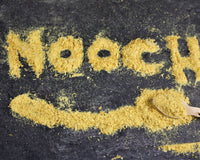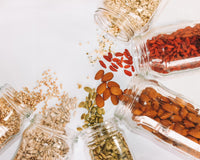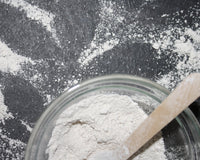Oat Flour
Oats are a versatile ingredient used in cooking and baking. Oats are a filling addition to meals and a great pick for sweet and savoury dishes. When using oats as an alternative for gluten- induced flour, it comes with plenty of positives.
Oat flour is a common supermarket flour, with organic options in farm shops and whole food shops. However, oat flour is fairly easy to make at home with the right equipment. If you have a bag of ground oats and an electric blender at home, you are three quarters of the way there already.
Oat flour is a great alternative for plain flour as it has a soft and fluffy cake texture, like the consistency of most cakes. Oat flour will rise slightly on its own, but needs an addition of baking soda for high-rise recipes like bread, scones, and cakes. With its fluffy texture, oat flour can make some great sweet or savoury recipes.
For all the sweet tooth bakers here are some simple yet effective ideas:
- Oat flour in your crumble recipe can transform the dessert to include a gluten-free crumble topping with a sweet, toasted flavour on top of the tasty baked fruit choice.
- For the bakers with a preference on texture, oat flour can give you chewy, crispy cookies, taking you back in time to the 19th century when they first became a hit.
- Oat muffins and oat pancakes are a great new breakfast choice. Incorporating fresh fruit, yoghurt, and some chocolate chips for extra sweetness.
- When considering the common ‘full’ effect oats have, oat protein balls are a great snack to include in your everyday diet.
Buckwheat Flour
Deriving from the Buckwheat grain, this flour is nutrient rich with plenty of health benefits to help with your physical diet. Filled with fibre, buckwheat flour is great for most savoury dishes and some sweet ones also. Buckwheat flour has a distinct earthy and nutty taste and to some people's opinion can have a bitter aftertaste.
Buckwheat, alike oats, have a great filling effect. This flour is a great option to use for satisfying breakfasts and lunches to keep you fuller for longer. The grain itself is a great alternative to quinoa, flax, amaranth, and polenta. However, when converted to a flour, Buckwheat is great to make rice and noodles. By mixing the dark flour with herbs and eggs. You can make plenty of tasty pastas.
Despite its distinct taste, Buckwheat can be used in sweet bakes. Its earthy and nutty flavours work extremely well with Banana. So, pancakes, muffins and cakes with banana, peanut butter and dark chocolate are a must for the sweet tooth trials for this flour.
Note to self: Be careful with allergens when considering Buckwheat an ingredient. Though it does not affect celiacs, it is a pseudo cereal, so any intolerances to grain should be examined.
Sorghum Flour
Another pseudo grain to add to this list is Sorghum. Also known as ‘Jowar’ flour, Sorghum flour is an extremely popular gluten-free flour in the baking world, as it has a lovely, sweet taste. Sorghum has a low elasticity and is an exceptionally light and fluffy flour, so the simpler the recipe, the better.
Similarly to Oats and Buckwheat, Sorghum flour wheat is a great flour to use in pancakes and porridges. Mixed with a starch to kick awake the raising element, Sorghum can be used to make sourdough breads, pizza bases, cakes and muffins.
When thinking about its natural sweetness, Sorghum can be a great ingredient for sweet sauces in lots of puddings and desserts. It works particularly well in baked sauces (in dishes with chocolate, cinnamon, tart fruit, and syrups) highlighting its sweet touch.
Be careful how much Sorghum you use at a time, as it can have a bitter aftertaste when used in significant quantities.
Teff Flour
This Ethiopian food source has been an extremely popular grain for centuries. This staple grain was converted into a flour and is now used for recipes that are sweet and savoury. Teff flour has underlying nutty flavour, it has great sources of fibre, minerals and vitamins too.
Take note- Teff does absorb lots of water when being cooked, so look at for those water ratios in your recipes, you may need to replace some liquids!
Teff flour can make some great meals including: pancakes, pizza crusts, waffles, fritters, porridge, cookies, and muffins. As a grain alone you can add teff into salads, falafels, roasted vegetable plates, and veggie burgers. Since the teff grain derives from Ethiopia, why not try and make the traditional teff flatbread called ‘Injera.’
Amaranth Flour
Another pseudo-grain to consider is Amaranth. This flour comes from grinding the seeds from the Amaranth plant. This grain is similar to Quinoa. Amaranth flour has a rich nutrient count with minerals such as: Iron, magnesium and calcium. Amaranth is also high in protein, therefore giving its state a strong structure for meals.
The naturally earthy/nutty flavouring this flour makes it perfect for bread-based meals. Tortillas, pizza bases, pizza crusts, savoury pancakes flatbreads and nutty bread. Amaranth gives a dense texture so have a think when you are pairing it with other foods.
Rice Flour
Rice and rice flour is a very popular option for gluten-free cooking as well as in Asian cuisines. This flour has a light texture, and mild natural flavouring, making it perfect for cooking, baking, frying and roasting.
There are two types of flour (white and brown) that differ in colour and texture. White rice flour is perfect for baking as it has a lighter texture. Brown rice flour is whole grain and can be used in more savoury meals because of its coarse but hearty texture.
In Asian tradition, rice flour is predominantly used to make noodles, pastas and dumplings. However, it is also commonly used in sauces and stews as a thickening agent.
Similar to the lists seen throughout this article, rice flour can be used in most meals. With its lighter texture it is popular to mix and match it with other gluten-free flours to balance out texture for more specific meals in baking.
Uniquely, rice flour also makes for a great frying batter! Whether is frying meats, sea food or adding crispness to your carbs and vegetables, rice flour can do it all.
Take note- Rice flour is high in carbohydrates rather than proteins, so if you count your calories, its best you take this into consideration if rice flour becomes an essential part of your diet.
Almond Flour
Created by blending blanched almonds, this flour is a great healthy alternative for many wheat flours. Almonds are a super-food nut with so many benefits to help the human body.
To name a few: monounsaturated fats, omega-9 fatty acids, plant-based proteins, fibres, low-glycaemic index, calcium, iron, magnesium and Vitamin E. These nutrients and minerals are great for keeping cardiovascular issues at bay, keeping your blood sugar levels normal and improving your digestive health.
Almond flour has a soft, light texture and a naturally sweet/nut flavouring, therefore, making it perfect for baked goods. Pancakes, cookies, brownies, banana bread, muffins, fruit bars, cakes and cinnamon rolls, this flour ticks boxes for a variety of dietary requirements. Almond flour can be great for those with gluten intolerances, celiac disease, or for those on a Keto/Paleo diet.
Almonds are a type of nut, so this flour is not suitable for those with a nut allergy.
Potato Flour
Potato flour is used with whole potatoes that are dehydrated and ground to make a fine powder. This is not to be confused with Potato Starch, which uses extracted potato starch.
Potato flour can make some well-structured meals with a satisfying texture: Pancakes, muffins, banana bread, dumplings, pizza dough, cakes and gravies.
Potato flour is amazing for retaining moisture, preventing meals from going dry, crumbly and going off quicker. This ability is all because of its high starch content. The starch (80-85%) creates great thickening and binding properties for foods.
This flour has some essential nutrients and minerals to support the body: Iron, potassium and vitamins C and B. These minerals work hand-in hand to help support the muscles, immune system and energy levels.
Potato flour is high in energy, so it is a great pick for a meal that will keep you going for a long-time. However, potato flour tends to be high in carbohydrates rather than proteins, so if you count your calories, its best you take this into consideration if it becomes an essential part of your diet.
When searching for the best gluten-free flours for baking and cooking always look out for the organic options in local farm shops and even whole foods online store.
Take note: Though the flours above are gluten-free be careful to check that the rest of your ingredients are gluten-free too.






